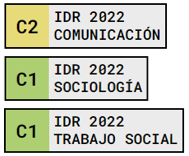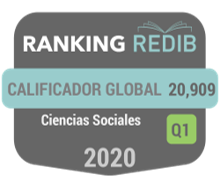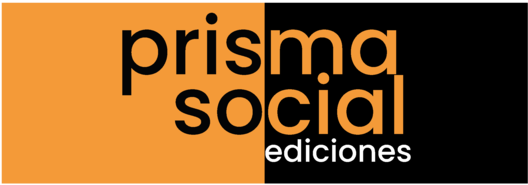Adolescents and Youtube: creation, participation and consumption
Palabras clave:
YouTube, videos, adolescentsResumen
This paper seeks to describe how adolescents use YouTube as a channel for expression and a space for cultural empowerment. To that end, from a communicological perspective, this is a review of the existing research into YouTube, placing particular emphasis on facets that can be transposed to the field of adolescence, in order to examine more closely aspects such as audiovisual behaviours and interactions; consumption; subjects and narratives channelled in this platform; the YouTubers phenomenon; uses; popularity and viral nature; and the characteristics of the videos. Finally, a proposal is made about aspects that can be studied in the future.
Adolescentes y Youtube: creación, participación y consumo
Resumen
Este trabajo pretende describir cómo los adolescentes usan YouTube como canal de expresión y como un espacio para el empoderamiento cultural. A tal fin, desde una perspectiva comunicológica, se presenta una revisión de la investigación existente sobre YouTube, haciendo especial énfasis en las facetas que son aplicables en el ámbito de la adolescencia, con el fin de examinar más de cerca aspectos como los comportamientos e interacciones audiovisuales; su consumo; los sujetos y narrativas canalizadas en esta plataforma; el fenómeno de los youtubers; los usos existentes; la popularidad y la naturaleza viral; y las características de los videos. Por último, se hace una propuesta sobre los aspectos que se pueden estudiar en el futuro.
Descargas
Citas
Aguaded Gómez, J.I & Sánchez Carrero, J. (2013). “El empoderamiento digital de niños y jóvenes a través de la producción audiovisual”. AdComunica 5. Retrieved January, 2015 (http://www.adcomunicarevista.com/ojs/index.php/adcomunica/article/view/109)
Aguilera, M de.; Adell, J.E. and Borges, E. (2010). “Apropiaciones imaginativas de la música en los nuevos escenarios comunicativos”. Comunicar 34: 35-44
AIMC (2015). EGM. Resumen general. Octubre 2014 a Mayo 2015. Retrieved July, 2015 (http://www.aimc.es/-Datos-EGM-Resumen-General-.html)
Alexa (2015). “Youtube.com’s Worldwide Rank”. Alexa.com. Retrieved October, 2015 (http://www.alexa.com/siteinfo/youtube.com)
Álvarez Gandolfi, F. (2015). “Jóvenes y plataformas digitales. Usos educativos de YouTube en talleres de Comunicación para el nivel secundario”. Congreso IX Guide; Universidad del Salvador (USAL), Buenos Aires, Argentina, 6-8 Mayo. Retrieved October, 2015 (http://uruguayeduca.edu.uy/UserFiles/P0001/File/2009/J%C3%B3venes%20y%20plataformas%20digitales%20%20Federico%20%C3%81lvarez%20Gandolfi.pdf)
Ardèvol, E. and San Cornelio, G. (2007). “Si quieres vernos en acción: YouTube.com. Prácticas mediáticas y autoproducción en Internet”. Revista Chilena de Antropología Visual, 10(3): 1-29
Axon, S. (2010, April 20). Hitler “Downfall” Parodies Removed from YouTube. Mashable. Retrieved October, 2015 (http://mashable.com/2010/04/20/dmca-hitler/#d3uEHfC8BPqR)
Barker, Valerie (2009). “Older adolescents’ motivations for social network site use: the influence of gender, group identity, and collective self-esteem”. CyberPsychology & Behavior 12(2): 209-213
Berrocal-Gonzalo, S.; Campos-Domínguez, E. and Redondo-García, M. (2014). “Media prosumers in political communication: Politainment on YouTube. Prosumidores mediáticos en la comunicación política: El «politainment» en YouTube”. Comunicar 22(43): 65-72
Botha, Elsamari (2014). “A Means to an End: Using Political Satire to Go Viral”. Public Relations Review 40(2): 363-374
Burgess, J. and Green, J. (2013). YouTube: Online video and participatory culture. John Wiley & Sons
Callejo Gallego, J. and Gutiérrez Brito, J. (2014). “La comunicación de los jóvenes adolescentes en las redes sociales”. Doxa Comunicación 19: 11-29.
Chau, C. (2010). “YouTube as a participatory culture”. New directions for youth development, 128: 65-74
Childwise (2012). The Monitor Pre-school Report 2012: Key behaviour patterns among 0 to 4 year olds. Norwich
CISCO (2015). Visual Networking Index: Forecast and Methodology, 2014–2019. Retrieved October, 2015 (http://www.cisco.com/c/en/us/solutions/collateral/service-provider/ip-ngn-ip-next-generation-network/white_paper_c11-481360.pdf)
Common Sense (2013). Zero to Eight: Children’s Media Use in America 2013. Retrieved October, 2015 (https://www.commonsensemedia.org/research)
Cooper, C. (2010, April 22). Newest YouTube Headache: Furor over Fuhrer Videos - Tech Talk - CBS News. CBS News.com. Retrieved October, 2015 (http://www.cbsnews.com/8301-501465_162-20003234-501465.html)
Courtois, C.; Mechant, P.; Ostyn, V. and Marez L. (2013). “Uploaders’ definition of the networked public on YouTube and their feedback preferences: a multi-method approach”. Behaviour & Information Technology 32(6): 612–624
Dias da Silva, P. and Garcia, J. L. (2012). “YouTubers as satirists: Humour and remix in online video”. JeDEM 4(1): 89-114
Duffy, P. (2007). “Engaging the YouTube Google-Eyed Generation: Strategies for Using Web 2.0 in Teaching and Learning”. The Electronic Journal of e-Learning 6(2): 119–130. Retrieved October, 2015 (http://www.ejel.org/front/search/index.html)
Duncum, P. (2011). “Youth on YouTube: Prosumers in a peer-to-peer participatory culture”. The International Journal of Art Education 9(2): 24-39. Retrieved September, 2015 (http://ed.arte.gov.tw/uploadfile/periodical/3052_9-2-p.24-39.pdf)
Edwards, R. and Tryon, C. (2009). “Political video mashups as allegories of citizen empowerment”. First Monday, 14(10). (http://firstmonday.org/ojs/index.php/fm/article/view/2617/2305)
Eftekhar, A.; Fullwood, C. and Morris, N. (2014). “Capturing personality from Facebook Photos and Photo-Related Activities: How Much Exposure Do You Need?” Computers in Human Behaviour, 37: 162-170
Erstad, O.; Gilje, Ø.; and Arnseth, H. C. (2013). “Vidas de aprendizaje conectadas: Jóvenes digitales en espacios escolares y comunitarios”. Comunicar 20(40): 89-98. Retrieved October, 2015 (http://www.revistacomunicar.com/indice/articulo.php?numero=40-2013-11)
Forbes México (2015). Los 10 youtubers más ricos del mundo. 16 October. Retrieved October, 2015 (http://www.forbes.com.mx/los-10-youtubers-mas-ricos-del-mundo/)
Gallardo Camacho, J. and Jorge Alonso, A. (2010). "La baja interacción del espectador de vídeos en Internet: caso Youtube España". Revista Latina de Comunicación Social 65: 421-435. Retrieved October, 2015 (http://www.revistalatinacs.org/10/art3/910_Malaga/32_Gallardo.html)
Gallardo, J. and Jorge, A. (2012). “El caso Youtube España: el fenómeno glocal en las redes sociales”. Telos, 92. Retrieved October, 2015 (http://sociedadinformacion.fundacion.telefonica.com/DYC/TELOS_92TELOS_EXPERIENCIAS/seccion=1271&idioma=es_ES&id=2012071612090001&activo=6.do)
Google (2015). “Statistics”. Retrieved October, 2015 (http://www.google.com/jobs/youtube/)
Haddon, L. and Vincent, J. (2015). UK children’s experience of smartphones and tablets: perspectives from children, parents and teachers. LSE, London. Retrieved October, 2015 (http://netchildrengomobile.eu/reports/)
Haddon, L. and Vincent, J. (eds.) (2014). European children and their carers’ understanding of use, risks and safety issues relating to convergent mobile media. Report D4.1. Milano: Unicatt. Retrieved October, 2015 (http://netchildrengomobile.eu/reports/)
Haridakis, P. and Hanson, G. (2009). “Social Interaction and Co-Viewing With YouTube: Blending Mass Communication Reception and Social Connection. Journal of Broadcasting & Electronic Media 53(2): 317–335.
Harrison, T.M. and Barthel, B. (2009). “Wielding new media in Web 2.0: exploring the history of engagement with the collaborative construction of media products”. New Media & Society 11 (1–2): 155–178.
Holloway, D.; Green, L. and Livingstone, S. (2013). Zero to eight. Young children and their internet use. LSE, London: EU Kids Online.
Holmbom, M. (2015). The YouTuber: A Qualitative Study of Popular Content Creators. Retrieved October, 2015 (http://www.diva-portal.org/smash/get/diva2:825044/FULLTEXT01.pdf)
Islas, O. (2011). “La sociedad de la ubicuidad, los prosumidores y un modelo de comunicación para comprender la complejidad de las comunicaciones digitales”. Revista ALAIC 7.
Jiménez, C. and Gaitán Caballero, B. N. (2013). “Análisis de los factores que motivan a los estudiantes de la Universidad Autónoma de Occidente a difundir contenidos virales en la Red”. Colombia, Santiago de Cali, Universidad Autónoma de Occidente. Retrieved October, 2015 (http://bdigital.uao.edu.co/bitstream/10614/5127/1/TCP01511.pdf)
Jones, J. (2010). The me in media: a functionalist approach to examining motives to produce within the public space of YouTube. Minnesota: University of Minnesota. Retrieved October, 2015 (http://conservancy.umn.edu/handle/11299//61916)
Lange, P.G. (2007). “Publicly private and privately public: social networking on YouTube”. Journal of Computer-Mediated Communication 13(1): 361–380.
Lapuente, M. (2011). “Migraciones del espacio social al espacio mediático: la figura del prosumidor”. VI Jornadas de Jóvenes Investigadores, 10-12 noviembre. Instituto de Investigaciones Gino Germani, Facultad de Ciencias Sociales, Universidad de Buenos Aires, Buenos Aires. Retrieved July, 2015 (http://www.aacademica.com/000-093/91.pdf)
Larrañaga, J. y Ruiz, A. (2009). “El modelo de negocio de Youtube”. Icono 14 12: 109-131.
Lenhart, A.; Smith, A.; Anderson, M.; Duggan, M.; Perrin, A. (2015). Teens, Technology and Friendships. Pew Research Center, August. Retrieved October, 2015 (http://www.pewinternet.org/2015/08/06/teens-technology-and-friendships/)
Livingstone, S.; Kirwil, L.; Ponte, C.; and Staksrud, E. (2014). “In their own words: what bothers children online?”. European Journal of Communication 29(3): 271-288.
Madden et al. (2013). Teens, social media, and privacy. Retrieved July, 2015 (http://www.pewinternet.org/Reports/2013/Teens-Social-Media-And-privacy.aspx)
Mascheroni, G. and Ólafsson, K. (2014). Net Children Go Mobile: risks and opportunities. Second Edition. Milano: Educatt. Retrieved (http://netchildrengomobile.eu/reports/)
Murolo, L. and Lacorte, N. (2015). De los bloopers a los youtubers. Questión 1(45). Retrieved October, 2015 (https://perio.unlp.edu.ar/ojs/index.php/question/article/viewFile/2407/2128)
Núñez, P., García, M .L. and Hermida, L.A. (2012). “Tendencias de las relaciones sociales e interpersonales de los nativos digitales y jóvenes en la web 2.0”. Revista Latina de Comunicación Social 67: 179-206. Retrieved June, 2015 (http://www.revistalatinacs.org/067/art/952_UCM/08_Patricia.html)
Nyberg, A. and Wiberg, C. (2012). Innovating social media: Five strategies for successful digital entrepreneurship. Innovation through Social Media (ISM). Retrieved July, 2015
OFCOM (2014). Children and Parents: Media Use and Attitudes Report. Retrieved July, 2015 (http://stakeholders.ofcom.org.uk/binaries/research/media-literacy/media-use-attitudes-14/Childrens_2014_Report.pdf)
Pea, R. et al. (2012). “Media use, face-to-face communication, media multitasking, and social well-being among 8- to 12-year-old girls”. Developmental Psychology 48(2): 327-336.
Pew Internet Project (2013). Teens, Social Media, and Privacy. Retrieved July, 2015 (http://www.pewinternet.org/2013/05/21/teens-social-media-and-privacy/)
Protégeles (2014). “Menores de edad y conectividad móvil en España: Tablets y smartphones”. Retrieved June, 2015 (http://www.diainternetsegura.es/)
Puente Bienvenido, H. and Pajares Tosca, S. (2013). “Metodologías de investigación online: la productividad fan en Youtube”. XI Congreso Español de Sociología. Retrieved July, 2015 (http://www.fes-web.org/uploads/files/modules/congress/11/papers/1939.pdf)
Renó, D. (2007). “YouTube, el mediador de la cultura popular en el ciberespacio”. Revista Latina de Comunicación 62. Retrieved from (http://www.ull.es/publicaciones/latina/200717Denis_Reno.htm)
Seo, H. et al. (2014). “Teens’ social media use and collective action”. New Media & Society 16(6): 883-902.
Shifman, L. (2012). “An anatomy of a Youtube meme”. New Media & Society 14(2): 187-203.
Suárez, E. V. (2015). “La música como elemento satírico en la edición de vídeos de contenido político en Youtube: el uso del Autotune”. Revista de Comunicación de la SEECI 37: 268-284.
Subrahmanyam, K.; Greenfield, P. and Michikyan, M. (2015). “Comunicación electrónica y generaciones adolescentes”. Infoamérica 9: 115-130. Retrieved June 2015 (http://www.infoamerica.org/icr/n09/IA9_Comunicacion.pdf)
West, T. (2011). “Going viral: Factors that lead videos to become internet phenomena”. Elon Journal of Undergraduate Research 76-84. Retrieved May. 2015 (https://www.elon.edu/docs/eweb/academics/communications/research/vol2no1/08west.pdf)
Youtube Oficial Blog (2007). YouTube Elevates Most Popular User to Partners. Retrieved September, 2015 (http://youtube-global.blogspot.se/2007/05/youtube-elevates-most-popular-users-to.html)
Descargas
Publicado
Cómo citar
Número
Sección
Licencia
Los autores/as que publiquen en esta revista aceptan las siguientes condiciones:
- Los autores/as conservan los derechos de autor.
- Los autores/as ceden a la revista el derecho de la primera publicación. La revista también posee los derechos de edición.
- Todos los contenidos publicados se regulan mediante una Licencia Atribución/Reconocimiento-SinDerivados 4.0 Internacional. Acceda a la versión informativa y texto legal de la licencia. En virtud de ello, se permite a terceros utilizar lo publicado siempre que mencionen la autoría del trabajo y a la primera publicación en esta revista. Si transforma el material, no podrá distribuir el trabajo modificado.
- Los autores/as pueden realizar otros acuerdos contractuales independientes y adicionales para la distribución no exclusiva de la versión del artículo publicado en esta revista (p. ej., incluirlo en un repositorio institucional o publicarlo en un libro) siempre que indiquen claramente que el trabajo se publicó por primera vez en esta revista.
- Se permite y recomienda a los autores/as a publicar su trabajo en Internet (por ejemplo en páginas institucionales o personales), una vez publicado en la revista y citando a la misma ya que puede conducir a intercambios productivos y a una mayor y más rápida difusión del trabajo publicado (vea The Effect of Open Access).


















